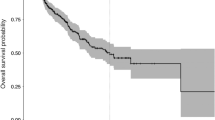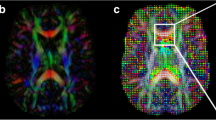Abstract
Brain tumor cells invade adjacent normal brain along white matter (WM) bundles of axons. We therefore hypothesized that the location of tumor intersecting WM tracts would be associated with differing survival. This study introduces a method, voxel-wise survival analysis (VSA), to determine the relationship between the location of brain tumor intersecting WM tracts and patient prognosis. 113 primary glioblastoma (GBM) patients were retrospectively analyzed for this study. Patient specific tumor location, defined by contrast-enhancement, was combined with diffusion tensor imaging derived tractography to determine the location of axons intersecting tumor enhancement (AXITEs). VSA was then used to determine the relationship between the AXITE location and patient survival. Tumors intersecting the right anterior thalamic radiation (ATR), right inferior fronto-occipital fasciculus (IFOF), right and left cortico-spinal tract (CST), and corpus callosum (CC) were associated with decreased overall survival. Tumors intersecting the CST, body of the CC, right ATR, posterior IFOF, and inferior longitudinal fasciculus are associated with decreased progression-free survival (PFS), while tumors intersecting the right genu of the CC and anterior IFOF are associated with increased PFS. Patients with tumors intersecting the ATR, IFOF, CST, or CC had significantly improved survival prognosis if they were additionally treated with bevacizumab. This study demonstrates the usefulness of VSA by locating AXITEs associated with poor prognosis in GBM patients. This information should be included in patient-physician conversations, therapeutic strategy, and clinical trial design.



Similar content being viewed by others
Abbreviations
- VSA:
-
Voxel-wise survival analysis
- AXITE:
-
Axons intersecting tumor enhancement
- WM:
-
White matter
- OS:
-
Overall survival
- PFS:
-
Progression free survival
- ATR:
-
Anterior thalamic radiation
- IFOF:
-
Inferior fronto-occipital fasciculus
- CST:
-
Cortico-spinal tract
- CC:
-
Corpus callosum
References
Stupp R, Mason WP, van den Bent MJ et al (2005) Radiotherapy plus concomitant and adjuvant temozolomide for glioblastoma. N Engl J Med 352(10):987–996
Ewelt C, Goeppert M, Rapp M, Steiger HJ, Stummer W, Sabel M (2011) Glioblastoma multiforme of the elderly: the prognostic effect of resection on survival. J Neurooncol 103(3):611–618
Filippini G, Falcone C, Boiardi A et al (2008) Prognostic factors for survival in 676 consecutive patients with newly diagnosed primary glioblastoma. Neuro Oncol 10(1):79–87
Jeremic B, Milicic B, Grujicic D, Dagovic A, Aleksandrovic J (2003) Multivariate analysis of clinical prognostic factors in patients with glioblastoma multiforme treated with a combined modality approach. J Cancer Res Clin Oncol 129(8):477–484
Li SW, Qiu XG, Chen BS et al (2009) Prognostic factors influencing clinical outcomes of glioblastoma multiforme. Chin Med J (Engl) 122(11):1245–1249
Fontaine D, Paquis P (2010) Glioblastoma: clinical, radiological and biological prognostic factors. Neurochirurgie 56(6):467–476
Lacroix M, Abi-Said D, Fourney DR et al (2001) A multivariate analysis of 416 patients with glioblastoma multiforme: prognosis, extent of resection, and survival. J Neurosurg 95(2):190–198
Simpson JR, Horton J, Scott C et al (1993) Influence of location and extent of surgical resection on survival of patients with glioblastoma multiforme: results of three consecutive Radiation Therapy Oncology Group (RTOG) clinical trials. Int J Radiat Oncol Biol Phys 26(2):239–244
Ellingson BM, Lai A, Harris RJ et al (2013) Probabilistic radiographic atlas of glioblastoma phenotypes. AJNR Am J Neuroradiol 34(3):533–540
Hammoud MA, Sawaya R, Shi W, Thall PF, Leeds NE (1996) Prognostic significance of preoperative MRI scans in glioblastoma multiforme. J Neurooncol 27(1):65–73
Ellingson BM, Cloughesy TF, Pope WB et al (2012) Anatomic localization of O6-methylguanine DNA methyltransferase (MGMT) promoter methylated and unmethylated tumors: a radiographic study in 358 de novo human glioblastomas. Neuroimage 59(2):908–916
Pedersen PH, Edvardsen K, Garcia-Cabrera I et al (1995) Migratory patterns of lac-z transfected human glioma cells in the rat brain. Int J Cancer 62(6):767–771
Belien AT, Paganetti PA, Schwab ME (1999) Membrane-type 1 matrix metalloprotease (MT1-MMP) enables invasive migration of glioma cells in central nervous system white matter. J Cell Biol 144(2):373–384
Lefranc F, Brotchi J, Kiss R (2005) Possible future issues in the treatment of glioblastomas: special emphasis on cell migration and the resistance of migrating glioblastoma cells to apoptosis. J Clin Oncol 23(10):2411–2422
Baldock AL, Ahn S, Rockne R et al (2014) Patient-specific metrics of invasiveness reveal significant prognostic benefit of resection in a predictable subset of gliomas. PLoS ONE 9(10):e99057
Ellingson BM, Cloughesy TF, Lai A, Nghiemphu PL, Pope WB (2011) Cell invasion, motility, and proliferation level estimate (CIMPLE) maps derived from serial diffusion MR images in recurrent glioblastoma treated with bevacizumab. J Neurooncol 105(1):91–101
Basser PJ, Mattiello J, LeBihan D (1994) MR diffusion tensor spectroscopy and imaging. Biophys J 66(1):259–267
Ulmer JL, Salvan CV, Mueller WM et al (2004) The role of diffusion tensor imaging in establishing the proximity of tumor borders to functional brain systems: implications for preoperative risk assessments and postoperative outcomes. Technol Cancer Res Treat 3(6):567–576
Witwer BP, Moftakhar R, Hasan KM et al (2002) Diffusion-tensor imaging of white matter tracts in patients with cerebral neoplasm. J Neurosurg 97(3):568–575
Le Bihan D (2003) Looking into the functional architecture of the brain with diffusion MRI. Nat Rev Neurosci 4(6):469–480
Yamada K, Kizu O, Mori S et al (2003) Brain fiber tracking with clinically feasible diffusion-tensor MR imaging: initial experience. Radiology 227(1):295–301
Clark CA, Barrick TR, Murphy MM, Bell BA (2003) White matter fiber tracking in patients with space-occupying lesions of the brain: a new technique for neurosurgical planning? Neuroimage. 20(3):1601–1608
Yuan J, Liu L, Hu Q (2013) Mathematical modeling of brain glioma growth using modified reaction-diffusion equation on brain MR images. Comput Biol Med 43(12):2007–2013
Swanson KR, Bridge C, Murray JD, Alvord EC Jr (2003) Virtual and real brain tumors: using mathematical modeling to quantify glioma growth and invasion. J Neurol Sci 216(1):1–10
Pope WB, Lai A, Mehta R et al (2011) Apparent diffusion coefficient histogram analysis stratifies progression-free survival in newly diagnosed bevacizumab-treated glioblastoma. AJNR Am J Neuroradiol 32(5):882–889
Ellingson BM, Malkin MG, Rand SD et al (2010) Validation of functional diffusion maps (fDMs) as a biomarker for human glioma cellularity. J Magn Reson Imaging 31(3):538–548
Hamstra DA, Chenevert TL, Moffat BA et al (2005) Evaluation of the functional diffusion map as an early biomarker of time-to-progression and overall survival in high-grade glioma. Proc Natl Acad Sci USA 102(46):16759–16764
Ellingson BM, LaViolette PS, Rand SD et al (2011) Spatially quantifying microscopic tumor invasion and proliferation using a voxel-wise solution to a glioma growth model and serial diffusion MRI. Magn Reson Med 65(4):1131–1143
Ellingson BM, Cloughesy TF, Lai A, Nghiemphu PL, Pope WB (2011) Cell invasion, motility, and proliferation level estimate (CIMPLE) maps derived from serial diffusion MR images in recurrent glioblastoma treated with bevacizumab. J Neurooncol 105(1):91–101
Jbabdi S, Mandonnet E, Duffau H et al (2005) Simulation of anisotropic growth of low-grade gliomas using diffusion tensor imaging. Magn Reson Med 54(3):616–624
Painter KJ, Hillen T (2013) Mathematical modelling of glioma growth: the use of diffusion tensor imaging (DTI) data to predict the anisotropic pathways of cancer invasion. J Theor Biol 323:25–39
Wen PY, Macdonald DR, Reardon DA et al (2010) Updated response assessment criteria for high-grade gliomas: response assessment in neuro-oncology working group. J Clin Oncol 28(11):1963–1972
Jenkinson M, Smith S (2001) A global optimisation method for robust affine registration of brain images. Med Image Anal 5(2):143–156
Jenkinson M, Bannister P, Brady M, Smith S (2002) Improved optimization for the robust and accurate linear registration and motion correction of brain images. Neuroimage 17(2):825–841
Taylor PA, Cho KH, Lin CP, Biswal BB (2012) Improving DTI tractography by including diagonal tract propagation. PLoS ONE 7(9):e43415
Taylor PA, Saad ZS (2013) FATCAT: (an efficient) functional and tractographic connectivity analysis toolbox. Brain Connect 3(5):523–535
Cox RW (1996) AFNI: software for analysis and visualization of functional magnetic resonance neuroimages. Comput Biomed Res 29(3):162–173
Varentsova A, Zhang S, Arfanakis K (2014) Development of a high angular resolution diffusion imaging human brain template. Neuroimage 91C:177–186
Bates E, Wilson SM, Saygin AP et al (2003) Voxel-based lesion-symptom mapping. Nat Neurosci 6(5):448–450
Talairach J, Tournoux P (1988) Co-planar stereotaxic atlas of the human brain. 3-Dimensional proportional system: an approach to cerebral imaging. Thieme Medical Publishers, New York
Binder JR, Desai RH, Graves WW, Conant LL (2009) Where is the semantic system? A critical review and meta-analysis of 120 functional neuroimaging studies. Cereb Cortex 19(12):2767–2796
Paez-Ribes M, Allen E, Hudock J et al (2009) Antiangiogenic therapy elicits malignant progression of tumors to increased local invasion and distant metastasis. Cancer Cell 15(3):220–231
Funding
Advancing a Healthier Wisconsin, and the MCW Cancer Center.
Author information
Authors and Affiliations
Corresponding author
Ethics declarations
Conflicts of Interest
None.
Electronic supplementary material
Below is the link to the electronic supplementary material.
Rights and permissions
About this article
Cite this article
Mickevicius, N.J., Carle, A.B., Bluemel, T. et al. Location of brain tumor intersecting white matter tracts predicts patient prognosis. J Neurooncol 125, 393–400 (2015). https://doi.org/10.1007/s11060-015-1928-5
Received:
Accepted:
Published:
Issue Date:
DOI: https://doi.org/10.1007/s11060-015-1928-5




